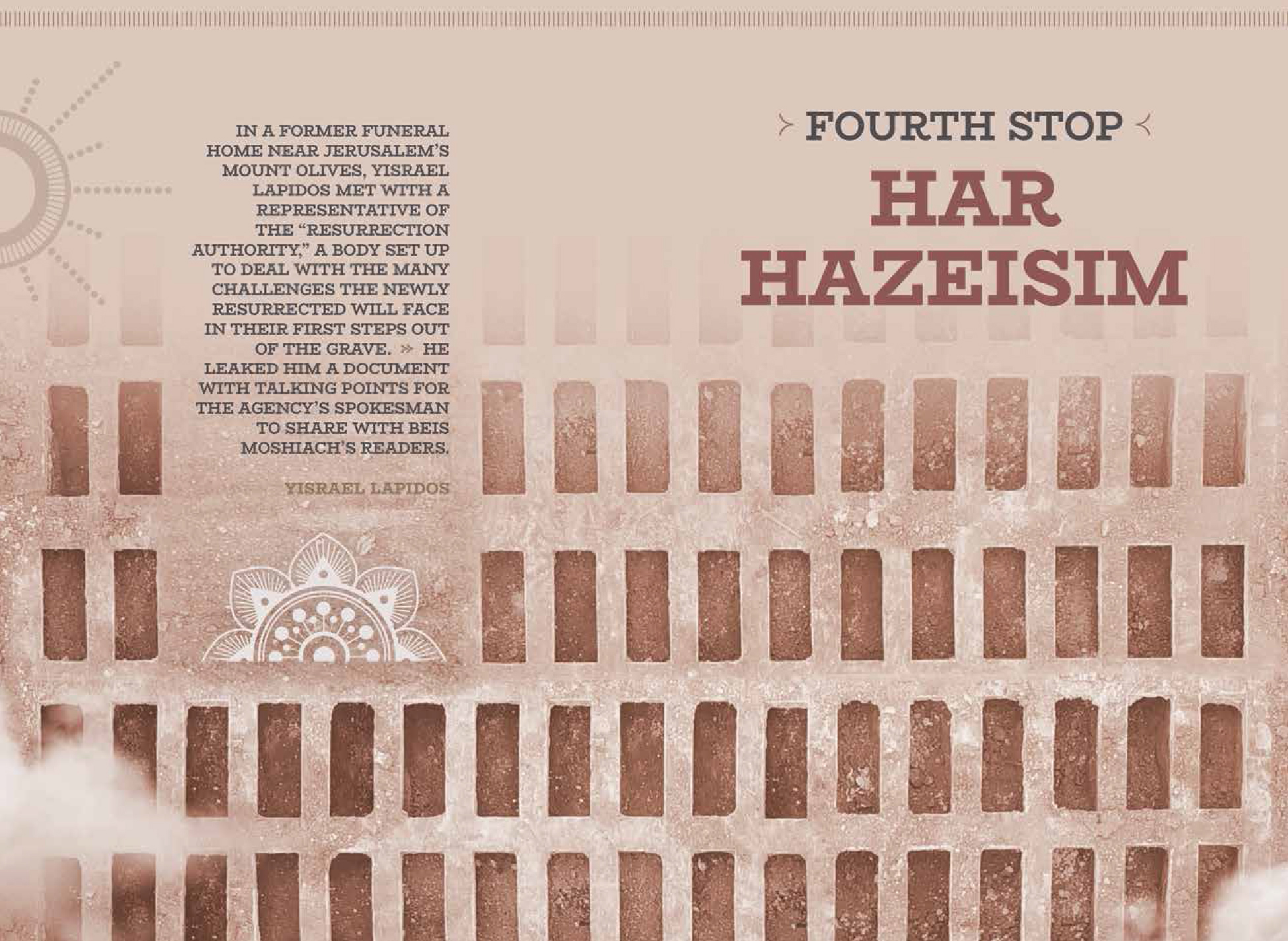Zero Hour: Resurrection On Har Hazeisim
In a former funeral home near Jerusalem’s Mount Olives, Yisrael Lapidos met with a representative of the “Resurrection Authority,” a body set up to deal with the many challenges the newly resurrected will face in their first steps out of the grave. He leaked him a document with talking points for the agency’s spokesman to share with Beis Moshiach’s readers • Full Article
Yisrael Lapidos, Beis Moshiach
“Apparently, the sound of the shofar that we heard throughout the land signaled the end of the global upheaval that characterized the history of humanity since it came into being.” With these words, the journalist and commentator, Menachem Barnea, began his popular column that is published on the first page of Yediot Acharonot.
“After a turbulent and dramatic period in the economic and political global arenas, the long awaited hope has materialized. The unbelievable rise of Moshiach ben Dovid to lead the government. This fact proves, more than anything else, that truth and facts are only relative concepts and that the entire world order can change in an instant according to the will of the One who spoke it into being.
“Now, our challenge is to gain familiarity with the world as we have never known it before. Some will say that the expression ‘dream come true’ is worn out from overuse, but future historians are definitely likely to reference the happenings which we are witnessing in just those terms.”
Even those who are used to arguing with Menachem Barnea, will find it hard, this time, not to agree with his comments infused with glowing optimism.
Prior to the dramatic upheaval: oppressive galus reality paved with challenges that brought along difficulties, trials and plenty of tragedies, which only intensified the push and and longing for Geula, while also causing many to not realize that it is actually about to happen, despite or perhaps because of all previous symptoms and prognostications.
At first, it sounded more like a fictional account or a wild fantasy, but after the incredible events that we were witness to, all cynicism melted away:
* The breathtaking appearance of Moshiach, the Lubavitcher Rebbe, in his beis medrash in New York, with his captivating smile and his vigorous signs of encouragement to the Chassidim.
* Their ascent to Eretz Yisrael along with the impressive, familiar, red-brick facade building, known as 770, which landed in Yerushalayim attached to the Third Beis Ha’Mikdash.
* The arrival of millions of Jews from all parts of the world, along with the lost tribes, and the list goes on and continues to be updated from the thousands of reports that continue to flood social media and the media.
Many of the events were anticipated by anyone who was focused on them including many Lubavitcher Chassidim, but no doubt, the unbelievable victory over the galus promises additional surprises that will crop up and amaze the world.
In the meantime, we will try and understand how we should ready ourselves for what appears to be a major and wondrous stage in the Geula of the Jewish people, that more vague and mysterious aspect that Jews have waited for over so many years, and spoken about it constantly, with yearning, in anticipation along with some small measure of inexplicable dread, because of the question of all questions: what will happen at the resurrection of the dead?
The following editorial published by the The Moshiach Times and The New York Times – in light of the merger of the two publications – provides a thoughtful analysis of the reasons for the very real tension in the air in anticipation of the resurrection of the dead.
FAMILIES ARE WORRIED
As of press time: The Beis Ha’Mikdash is already in its place. Moshiach is teaching a new Torah. There is dancing in the streets and dozens of historic events are being reported constantly in the news broadcasts and the live coverage feeds. However, it seems that there are even greater moments in store.
The first sign of the return of people from the “next world” was actually seen at the exact time that Moshiach came. After we had the privilege to meet face to face with the beloved tzaddikim whom we knew, until only recently, through written accounts, such as Moshe Rabeinu and Aharon Ha’Kohen, the line “We have yet to meet someone who returned from there,” no longer applies. Although in the past, people died every day and we did not merit to see them return from the next world, now it no longer sounds bizarre.
Especially after we ourselves experienced the Geula revelations without having died and undergone the process of resurrection. Experts have informed us that, at first glance, it seemed as if we too were required to go through the death process as it says, “and to dust you shall return.” However, the redeemer of Israel, the Rebbe, issued guidelines stating that we need to move on to the eternal life that follows the resurrection without undergoing death.
The Rebbe’s sweeping directive was based on the writings of Kabbala and Chassidus which provide a spiritual substitute for physical death: the total nullification and putting to death of the feeling of self. This type of death uplifts our bodies to the necessary level of refinement to receive the enormous G-dly revelations of the Geula, and saves us from having to experience physical death.
It’s important to note that there had been various parties who found it difficult to understand from where Chabad Chassidim got the strength, in the final moments of galus, to believe that the Rebbe is chai v’kayam, even before the removal of the veil of concealment. After they themselves crossed the border from galus to Geula and remained alive and unharmed, they now have an easier time understanding this directive of the Rebbe that was said in reference to himself.
Now, as of the time of writing these lines, masses of people have been sighted at the nearby terminal close to Har HaZeisim as they anxiously wait and listen to the announcements and are glued to the information screens to know when their relatives will appear. Thousands of widows and children are crowding the information desks, wanting to know how/when they will meet with their loved ones again who were lost in the bitter galus.
The order of the resurrection of the dead changes according to several factors including: their personal character and their work in the world, the location of their grave whether in Eretz Yisrael or outside it, and is also according to an alphabetical list of names. This means that a Jew who learned Torah, did mitzvos, was humble, buried in Eretz Yisrael and whose first name begins with alef, will appear among the first as soon as the resurrection process begins at a later stage in the Geula.
Interestingly, the Fathers of the nation, Avrohom, Yitzchok and Yaakov, are missing from the Geula ceremonies. A leading member of the intelligence community issued a statement that the Avos, who are buried in the Meoras Hamachpela in Chevron, asked that they not be resurrected early, and that they appear only after the resurrection of everyone else, so as to arise to the joy and delight at the sight of all their descendants rising from their graves and seeing the land full of tzaddikim and Chassidim.
SNEAK PEEK AT THE NOT YET PUBLIC PRESS RELEASE
A moment before the new wave of resurrection on the slopes of Har HaZeisim, the exclusive spot where the resurrection vision will come to pass, Beis Moshiach uncovered a copy of the draft document composed by members of the “esurrection authority” who are responsible for order at the “resurrection main terminal.” Its intended purpose is to quieten somewhat the public agitation on the Temple Mount and to take the pressure off of the information centers that are collapsing under the high volume of callers.
Under the headline, “Everything You Wanted to Know about the Resurrection Process,” members of the “esurrection authority” address a number of burning questions that are asked repeatedly. Here they are:
Who will rise at the resurrection?
All Jews will be resurrected. This is because every Jew did some mitzva in his lifetime, even if he did so lacking the awareness that a mitzva was involved. The holiness that enveloped his body when he did the mitzva is waiting for him in the era of the resurrection, when he can enjoy that holiness being revealed within him. Therefore, Chazal say “Every Jew has a share in the world to come.” All Jews, throughout the generations, will arise in the resurrection of the dead!
What about infants and fetuses?
Good question. They will also definitely be resurrected. The fact that any mitzva is sufficient to merit resurrection, explains the psak halacha that even a baby that died before it was circumcised is circumcised before it is buried. The halacha even says that “if they forgot and buried him, the grave is opened in order to circumcise him.” This is in order “to serve as a remembrance that they will have compassion on him from heaven and he will live at the resurrection of the dead.” Furthermore, even a fetus that was unable to develop and was miscarried, will also merit to live in the era of resurrection.
A soul that spent time in several bodies as reincarnations – which body will it return to?
The soul will return to each human reincarnation. All human versions of the same neshama will rise at the resurrection of the dead, except for a neshama that nearly completed all it had to do and was only reincarnated to take care of a few minor things. That neshama will rise only in its primary body.
How can one neshama be split into several bodies at the same time?
The spiritual existential structure of the neshama is such that every part of it can become a completely independent existence, just like stem cells divide and create new stem cells.
How is it possible for a soul to return to a body that rotted in the grave?
There are two possibilities:
* A formation process in which the bones reconnect, the veins and sinews reattach, followed by the appearance of flesh and then the covering of skin.
* A process similar to the formation of a fetus in the mother. First skin forms around the embryo, and then the flesh begins to grow and then forms the limbs of bone and sinew.
What will be the primary component that will serve as a basis for this process?
Again there are two possibilities:
A certain small bone, the size of an almond which is why it is called the luz bone, and which is located at the end of the spine. Another opinion places its location as under the brain, where the knot of the head tefillin goes.
The “melo tarvad rekev” (large spoonful – measuring two handfuls – of rot) from the decomposed body. This also represents that same bone, but as it is in a puree form mixed with the dew of resurrection.
How old will the resurrected person be?
People will be the age they were when they died. It is possible that a father who died at age 30 will be younger than his child who is already 60. Regarding this encounter it says, “Then our mouths will be filled with laughter.”
Will bodies be naked or clothed?
Clothed.
What clothes will they have?
Two options: The shrouds they were clothed in or the clothing they were accustomed to wearing in their lifetime.
What about those who died from an illness. Will they rise as healthy people?
As far as health, the way the person left is the way he will return. If he left blind, he will return blind, if deaf, he will return deaf, if mute, he will return mute, and then Hashem will heal them.
A woman who was widowed and remarried. Whose wife will she be?
A widow who remarried will go back to her first husband after the resurrection, for both of them are halves of the same neshama.
What will happen to those who opposed Chassidus?
We are promised (Shmuel II 14:14) “lo yidach mimenu nidoch” (a banished person does not remain banished from Him). Even those who opposed Chassidus will be resurrected and will ask Moshiach to teach them pnimiyus ha’Torah so they too can receive their portion.
CONCLUSION
Until we return with our next report, it is worth citing the line with which Barnea ends his column:
And saving the best for last, let us not forget the stubborn Chabadnikim who insisted on sharing the wealth in advance. I am sure that the Rebbe, beloved to us all, Melech Ha’Moshiach, who is so proud of his Chassidim, will award them with the prestigious “Presidential Award for Volunteerism.” However, if I may, please allow me to say on my behalf and on behalf of many others: Thank you!
*
The magazine can be obtained in stores around Crown Heights. To purchase a subscription, please go to: bmoshiach.org
213
Join ChabadInfo's News Roundup and alerts for the HOTTEST Chabad news and updates!











































What happens if a divorced woman who had children with her first husband, later marries another man. Pethaps she has children with the second husband, perhaps she lives happily with him but they did not have children together.
When this woman dies, or Maybe Moshiach comes while she is still alive, who will she be with in the resurection?
Does she have to go back to be with the first husband?
What if that first husband also remarried?
What if both couples want to remain with their spoise from second marraige?